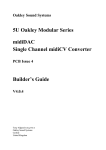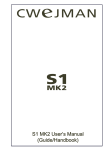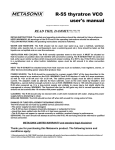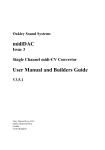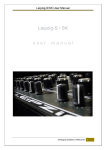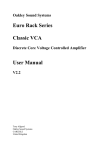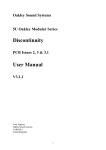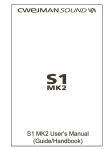Download midiDAC User Manual - Oakley Sound Systems
Transcript
Oakley Sound Systems 5U Oakley Modular Series midiDAC Single Channel midiCV Converter PCB Issue 4 User Manual V4.0.2 Tony Allgood B.Eng PGCE Oakley Sound Systems Carlisle United Kingdom The suggested front panel layout for the 2U wide MOTM format module. 2 Introduction This is the User Manual for the issue 4 midiDAC midi to CV convertor 5U module from Oakley Sound. This document contains an overview of the operation of the unit, the midiDAC PIC specifications and the calibration procedure. For the Builder's Guide, which contains a basic introduction to the board, a full parts list for the components needed to populate the boards, and a list of the various interconnections, please visit the main project webpage at: http://www.oakleysound.com/mididac.htm For general information regarding where to get parts and suggested part numbers please see our useful Parts Guide at the project webpage or http://www.oakleysound.com/parts.pdf. For general information on how to build our modules, including circuit board population, mounting front panel components and making up board interconnects please see our generic Construction Guide at the project webpage or http://www.oakleysound.com/construct.pdf. The issue 4 midiDAC fitted to a 2U wide natural finish Scheaffer panel. 3 The Oakley midiDAC midi to CV convertor module The issue 4 midiDAC is a single channel midi to analogue convertor. This project is a joint development between Oakley Sound and Trevor Page. Trevor wrote the firmware for the processor used in this project. The midiDAC is designed to drive any 1V/octave synthesiser or modular system. Let us first have a look at the different outputs available. Gate: +5V gate (or optional +15V gate) Pitch CV: 127 steps of 12 bit accurate pitch voltage conforming to 1V/octave (trimmable). Pitch bend may be added to this signal, and the maximum bend interval (up to one octave) can be adjusted from a front panel control. Velocity: 0 to 10V proportional to midi note on velocity. Pitch Bend: -5V to +5V proportional to pitch bend wheel position. 0V corresponds to a centred wheel. Modulation: 0 to 10V proportional to modulation wheel position. Aftertouch: 0 to 10V proportional to midi channel aftertouch. CC # 100: 0 to 10V proportional to midi controller number 100. Legato: This signal goes to +5V when two notes are played at the same time. This can allow slides to be activated at will; TB303 style. An optional external switch may be used to override the automatic activation of slide. Slide may be turned off by transmitting the standard midi glide/slide command. Also featured on the circuit board itself is a 3-way header to directly feed the Oakley ‘CVgate’ buss on the Dizzy board. The design also features a midi thru circuit which is greatly improved on the previous issue midiDAC designs. The processor used in this project is a PIC16F628 running at 4 MHz. Although this PIC has a lower clock speed than issue 1 and 2 midiDAC boards, its onboard UART allows it to process midi data far more efficiently. Please note: this product does not support the use of V/Hz or linear VCOs. These are found on some Yamaha and Korg analogue products, and just one Roland, the SH-2000. 4 Other Features There is a note stack within the firmware to allow the midiDAC to remember notes pressed. Thus if two or more notes are pressed at the same time, the oldest notes will be remembered so that if the more recent notes are removed the pitch will return to the still pressed older notes. The midiDAC also includes a TB303 style slide circuit. This can be turned either by engaging a switch, or by playing two notes at once. The pitch will glide up or down to the most recently pressed note. A pot can control the speed of the slide. Note retriggering is an option that can be changed on the fly. A simple switch or link can be used to select whether it is on or off. Ordinarily, when a note is pressed the gate always goes high. However, if a second note is pressed while another is still held down, the pitch CV will change but the gate remains high. The envelope generators on your synth will not retrigger. This is typical of Moog synthesisers. It can be useful. The 'Retriggering' mode allows the gate to drop momentarily when any new note note is pressed if there is a note already down. Thus, when the pitch CV changes, the envelopes will be retriggered, just like a normal note. This allows fast keyboard runs to be easily achieved. The new suggested panel layout incorporates both the glide and re-trigger switches. The midiDAC features a built in midi THRU port. This essentially produces a copy of the midi input signal which can be then fed to another midi unit. The issue three and four midiDAC units have a much faster THRU circuit that feature less data skew. Both the opto isolator and the THRU buffer are high speed devices so longer midi chains can be tolerated. Even so, long midi chains are generally to be avoided in any system. If you intend to use an older issue Oakley midiDAC with your new midiDAC in the same chain, then put the older one last in the chain. The module requires a split supply of +/-15V at around +40mA and -30mA. +/-12V operation is not supported. 5 PIC Firmware Data Version 2.2 The PIC could in theory generate 8 output control ‘voltages’ when used with a single DAC and 8-channel demultiplexer. However, we only use six of them in this version of the midiDAC firmware: Output CV generated 1 2 3 4 5 6 7 8 Pitch CV Modulation Wheel Note on velocity Pitch bender Aftertouch CC 100 Reserved Reserved The PIC also generates two digital type signals direct from its own ports. These are gate and slide. The former goes low when any note on is received on the selected midi channel and will go high when a note off, or key velocity zero, is received. It will briefly blip high in the case of ‘legato mode’ off if a second (or third, etc.) note is pressed whilst others are still held down. The Slide output will go low if more than one note is active on the selected midi channel. The slide will go high if there are no overlapping notes. For both logic outputs, it is expected that the PIC will drive NPN inverting stages. This is to protect the PIC from improper connections to the true slide and gate outputs. It also provides the facility to level shift upwards very easily. A third logic output is also available from the PIC that can drive a midi active LED and suitable current limiting resistor. This feature is unused in the midiDAC module. This output goes low for 500mS if any valid midi data is present on the midi port. 6 Midi Channel selection Midi channel is selected by four lines which must be either floating or be grounded. The simplest way to set midi channel is with a 4-way DIP switch which shorts the data line to ground. 0 is switch closed (ON) and 1 is switch open (OFF). Binary codes are being read pin 4 to pin 1. Pin 4 is MSB, pin 1 is LSB. Code 0000 0001 0010 0011 0100 0101 0110 0111 1000 1001 1010 1011 1100 1101 1110 1111 Midi Channel 1 2 3 4 5 6 7 8 9 10 11 12 13 14 15 16 For example, to set midi channel 3, set the DIP switch to 0010. That is, 1 on, 2 off, 3 on, 4 on. This midiDAC is set to receive midi data on channel 3 7 Gate Trigger Modes The midiDAC allows the selection of two gate trigger modes via the ‘Legato mode’ switch. This is marked on the new PCB as ‘RE-TRIG’. You can connect a simple SPST switch to this or a simple jumper. The setting of this switch/jumper determines how the gate signal responds to overlapping notes. Closing this switch, or fitting the jumper, enables multiple gate triggering for legato playing. This is the re-trig option. The gate signal is taken briefly low at the start of a new note, even if the fingers haven’t left the keyboard from the previous note. With the switch open, or leaving the position blank, the gate does not retrigger for overlapping notes. This is the classic analogue keyboard method and more suitable for those TB303 slides. Legato Mode may also be enabled or disabled via the Legato Footswitch MIDI messages. If these messages are to be used, the Slide Mode switch on the midiDAC unit should remain in the off position. midiDAC Implementation of MIDI Controllers The following table summarises the MIDI controllers supported by the midiDAC firmware. Hex Dec Midi Controller Definition Implementation on the midiDAC 41h 65 Portamento (Slide) 44h 68 Legato Footswitch 78h 120 All Sound Off 79h 121 Reset All Controllers 7Bh 123 All Notes Off 7Ch 124 Omni Mode Off 7Dh 125 Omni Mode On 7Eh 7Fh 126 127 Poly Mode Off Poly Mode On On / Off Switches the portamento (slide) function Controls the gate retrigger mode. 0 to 63 = off, 64 to 127 = on. Silences all notes & clears accent/gate/slide. Data byte = 0 for this controller. Centres Pitch Wheel and zeroes various controllers. Data byte = 0 for this controller. Silences all notes & clears accent/gate/slide. Data byte=0 for this controller. Unit responds only to selected MIDI channel. Data byte=0 for this controller.* Unit responds to any MIDI channel. Data byte=0 for this controller.* All notes cleared* All notes cleared* * In accordance with MMA specifications, all notes are cleared when these controller messages are received. 8 Note Priority The midiDAC firmware uses last note priority. That is, it will assign the pitch CV to the last note to be held. However, all 'overlapped' notes are still retained in memory and are reactivated in order should the most recent notes to be held be released. Firmware Bugs As far as we know there are no known issues with the software in its current state. The design has been tested and used extensively and we have not found any problems. The midiDAC has proved very rugged and is very reliable. However, there was one report that auxiliary CV outputs were unstable when the selected midi channel was between 9 and 16 and when the midi buss was very busy. We were unable to reproduce this so it may have been poorly performing midi buss on the user's system. But it may have been that we were 'lucky' in not being able to replicate exactly the fault conditions. In any case, if you do notice any problems with the way the midiDAC handles midi data, please do let me know. Copyright Notice Please note: No permission is granted to copy in anyway, or alter, the PIC firmware provided on the midiDAC PIC. The PIC is copy protected and we will not tolerate any attempt at bypassing this protection. A lot of hard work has gone into the design of the firmware, please do not steal it from us. The firmware is not available separately, although pre-preprogrammed PICs may be supplied to interested parties wanting to develop midi-CV interfaces for their musical projects. Please contact me at Oakley Sound for more information. 9 Calibration There are two trimmers on the midiDAC PCB. Both of them are designed to allow you to make the midiDAC respond correctly to the rest of the modular system. If you already have a perfectly tuned and calibrated system, it is best to trim the midiDAC to suit your system rather than the other way around. 1. V/OCT. This controls the scaling of the pitch CV output. That is, how much the VCO pitch will change with every note increment on the controlling keyboard. If you already have a calibrated set of VCOs with your current system it is best to set the midiDAC’s V/OCT to match your existing set up. Therefore, connect the midiDAC to one of your VCOs and adjust V/OCT until you get perfect tuning. Remember altering V/OCT will affect all notes on the keyboard, so you need to be looking at getting an octave interval between the notes rather than setting absolute pitch of one note. The INIT trimmer can be used for setting absolute frequency. If you do not have an existing system and the midiDAC is your first module, a perfectly calibrated midiDAC will then ensure that the rest of the system will be true. Connect the midiDAC to a keyboard or computer midi interface and power up. Allow the module to settle by leaving it on for ten minutes or so. Set the TUNE pot to its middle position. To ensure that the pot is perfectly centralised, measure the voltage on the wiper of the pot with respect to ground. Fine tune the pot until the voltage is between +20mV and -20mV. You may find it easier to measure this voltage at the left hand end of R4. Ground can be obtained anywhere connected to 0V. The mid point of C20 and C21 is a handy location for 0V. Now play the highest C on your controller keyboard. Use the octave select buttons to ensure your controller is set to produce the highest octave. Your keyboard will have sent one of two notes. Older midi controllers may actually have sent midi note 127 which is G9. If this is the case you should adjust V/OCT until pin 1 of U1 gives -10.58V. If your controller sent midi note number 120 which is C9 then you should adjust V/OCT until pin 1 of U1 gives -10.00V. If you are unsure which note your controller is sending then don't worry. If it's sending G9 you'll be able to get -10.58V easily enough. If it's sending C9 then you won't be able to trim to -10.58V but you will be able to trim to -10.00V. In either case you should verify that for every octave you go up the keyboard the voltage on pin 1, U1 changes by -1.00V. That is if C9 is -10V, then C8 will be -9V, C7 will be -8V and so on. If you are using a DAW or other midi software program then send the midiDAC note 127 and adjust V/OCT until pin 1 of U1 gives -10.58V. 2. INIT. This adjusts the offset applied to the pitch CV. Adjust this to tune the pitch of your master VCO. Set the TUNE pot on the front panel to the centre position before you start the adjustment of the INIT trimmer. The position of this trimmer will very much depend on your VCO setup and there is no specific procedure to set this. Simply adjust INIT until you are 10 happy that the VCOs in your modular can be transposed by the keyboard over your chosen musical range. Final Comments I hope you enjoy using the Oakley midiDAC midi to CV convertor module. If you have any problems with the module, an excellent source of support is the Oakley Sound Forum at Muffwiggler.com. Paul Darlow and I are on this group, as well as many other users and builders of Oakley modules. If you have a comment about this user manual, or have a found a mistake in it, then please do let me know. Last but not least, can I say a big thank you to all of you who helped and inspired me. Thanks especially to all those nice people on the Synth-diy and Analogue Heaven mailing lists and those at Muffwiggler.com. Tony Allgood at Oakley Sound Cumbria, UK © May 2011 – Updated December 2011 No part of this document may be copied by whatever means without my permission. 11











